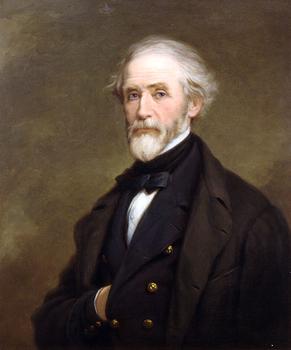Noted American millitary theorist and professor at the United States Military Academy at West Point.
>Biographical Information
| Name: | Dennis Mahan |
|---|---|
| Full name: | Dennis Hart Mahan |
| Born on | 2 April 1802 in New York, New York, USA, North America |
| Deceased on | 16 September 1871 in New York, New York, USA, North America |
Short biography of Dennis Hart Mahan
Mahan spent his youth in Norfolk (Virginia) and studied at West Point Military Academy, where he was best in his class and graduated in 1824. After two years of lecturing in mathematics at West Point, Mahan was sent to France by the Department of War for a three-year study tour in which he was to investigate state building projects and military establishments. Sponsored by the French government, Mahan spent more than 12 months at the École d'application de l'Artillerie et du Génie in Metz, where Poncelet – an outstanding engineering personality who fused together science and engineering to form applied mechanics – was on the teaching and research staff. In Paris, Mahan was a regular guest of the legendary French general and liberal politician La Fayette (1757–1834). Mahan returned to West Point in 1830 and was released by the Engineering Corps initially for an interim period so that he could take up a post as acting professor, and finally (1832) as full-time professor, for civil and military engineering, a post he held until his death. Like no other during that period, Mahan, through his teaching and his books, had an influence on the self-image of the American civil engineer that endured into the final decades of the 19th century, a period that was determined by the tasks of internal colonisation through the military-like provision of infrastructure. To some extent, the US Army Engineering Corps and West Point adapted Vauban's Corps des Ingénieurs militaires and the emerging engineering schools of 18th-century France on a higher level. For example, Mahan published not only the first American book on fortifications (1836), but also the first American book on civil engineering, which in the first place was aimed at the West Point cadets [Mahan, 1837], but later became a standard work for civil engineers in the USA. The book includes numerous sample calculations from Navier's Résumé des Leçons [Navier, 1826]. In his introduction, Mahan recommends that “the best counsel that the author could give to every young engineer is to place in his library every work of science to which M. Navier's name is in any way attached” [Mahan, 1837]. Mahan republished Moseley's 1843 monograph The mechanical principles of engineering and architecture in 1856 [Moseley, 1856] and enriched it with numerous original ideas; in Germany, Hermann Scheffler adopted Moseley's “mechanical principles” in a creative way around the same time [Scheffler, 1857]. Mahan therefore implanted the structural theory of Navier and Moseley into the knowledge canon of the American civil engineer. In historical terms, Mahan's contribution to the development of the principles of civil engineering in the USA bridges the transition from the constitution phase (1825–50) to the establishment phase (1850–75) of structural theory.
Main contributions to structural analysis:
- An elementary course of civil engineering [1837]
- A treatise on fortification drawing and stereotomy [1865]
- Descriptve geometry, as applied to the drawing of fortification and stereotomy [1870]
- A treatise on civil engineering [1878]
Source: Kurrer, Karl-Eugen The History of the Theory of Structures, Wilhelm Ernst & Sohn Verlag für Architektur und technische Wissenschaften GmbH, Berlin (Deutschland), ISBN 3-433-01838-3, 2008; p. 746
Relevant Websites
Relevant Publications
- (2008): The Architectural Education of Nineteenth-Century American Engineers: Dennis Hart Mahan at West Point. In: Journal of the Society of Architectural Historians, v. 67, n. 2 (June 2008), pp. 222-247.
- (2008): The History of the Theory of Structures. From Arch Analysis to Computational Mechanics. 1st edition, Wilhelm Ernst & Sohn Verlag für Architektur und technische Wissenschaften GmbH, Berlin (Germany), ISBN 978-3-433-01838-5, pp. 848.
- (2018): The History of the Theory of Structures. Searching for Equilibrium. 2nd edition, Wilhelm Ernst & Sohn Verlag für technische Wissenschaften, Berlin (Germany), ISBN 978-3-433-03229-9, pp. 1026.
- About this
data sheet - Person-ID
1009848 - Published on:
05/09/2013 - Last updated on:
22/07/2014





